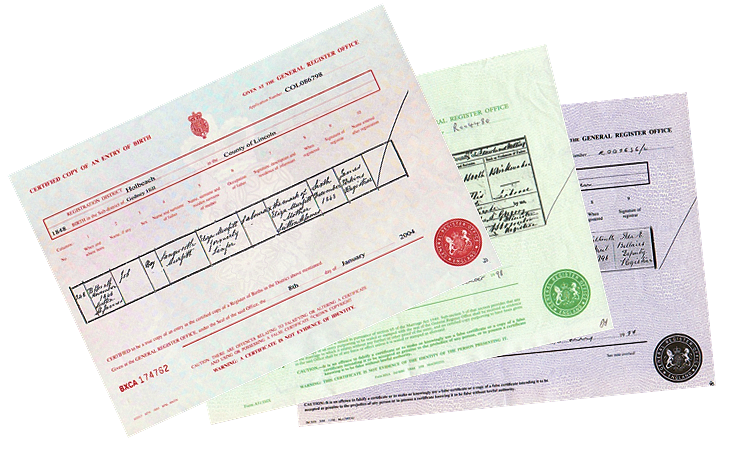
Civil registration (the government registration of all births, deaths, and marriages) started in England and Wales on the 1st July 1837. However, failing to register a birth wasn’t punishable with a fine until 1874. In the early days of civil registration, it’s been estimated that as many as 15-20 per cent of births were never registered in some areas.
Civil registration began in Scotland in 1855 and in Ireland in 1864.
4.1 What information is there on a certificate?
Birth, marriage and death certificates contain varying amounts of information.
4.1.1 Birth Certificates
A birth certificate contains the following information:
- The child’s forenames
- Sex
- Date of birth
- Place of birth
- Mother’s full name and maiden name
- Father’s full name and occupation if married to the mother
- Name, address and relationship to child of the person who registered the birth.
In Scotland the following additional information would be given:
- Time of birth
- Date and place of parents’ marriage
4.1.2 Marriage Certificates
A marriage certificate contains the following information:
- Date of Marriage
- Place of Marriage
- Whether by banns, licence or certificate
- Name and age of bride and groom
- Occupations of bride and groom
- Marital status of bride and groom
- Current address of bride and groom
- Names and occupations of the fathers of the bride and groom
- Names of witnesses
In Scotland the following additional information would be given:
- Mother’s name and maiden name
- For regular marriage – name of officiating minister (or registrar from 1940)
- For irregular marriages – date of conviction (to 1939), decree of declarator or sherriff’s warrant
4.1.3 Death Certificates
Death certificates contain the following information:
- Full name of deceased
- Date of death
- Place of death
- Given age
- Cause of death
- Occupation (or name and occupation of husband if the deceased was a married or widowed woman)
- Name, address and family relationship (if any) of the person who reported the death.
In Scotland the following additional information would be given:
- Marital status
- Spouse’s name
- Sex
- Father’s name and rank or profession
- Mother’s name and maiden name
4.2 Ordering Certificates
You can obtain your certificates from one of two sources:
- The General Register Office (GRO)
- The local register office where the event took place
Copies of Birth and Death Certificates can be ordered on line here:
https://www.gov.uk/order-copy-birth-death-marriage-certificate
Birth, Death and Marriage certificates can also be ordered (in most cases) from English and Welsh Register Offices. You should make payments to ‘The Superintendent Registrar’ unless other instructions are given with the address. If the register entry is not at the office where you sent the application, they MAY forward your request to the correct office. Please enclose a self addressed envelope. Within the UK please send a stamped SAE.
This site shows the addresses of local register offices:
http://www.genuki.org.uk/big/eng/RegOffice
Much more information about birth, marriage and death certificates (and the information they contain) can be obtained from this excellent site:
http://www.dixons.clara.co.uk/Certificates/indexbd.htm
4.2.1 GRO index reference
The General Register Office allocates a reference to every event of birth, marriage or death registered in England and Wales. This relates to the year, quarter, and district that the entry was registered in. By giving the GRO this index reference it allows them to quickly identify the correct entry and charge less for people who can quote the GRO index. This reference is only of use to the General Register Office and not to local registration offices, who have their own system.
Many Family History Societies have a copy of the GRO indexes. For instance the Family History Society of Cheshire has a copy of the GRO indexes at the Society’s Research Centre (members only) in Alderley Edge. http://www.fhsc.org.uk/fhsc/alderley.htm
The GRO indexes are also available in some major libraries and on the Internet.
4.2.2 Internet GRO indexes
FreeBMD is an ongoing project, which is transcribing the Civil Registration index of births, marriages and deaths for England and Wales, and provides free Internet access to the transcribed records. It is a part of the Free UK Genealogy family, which also includes FreeCEN (Census data) and FreeREG (Parish Registers). At present please note they have not yet transcribed the whole index.
UKBMD www.ukbmd.org.uk gives guidance about other sites who have indexes of Birth, Death and Marriage certificates -like the excellent Cheshire BMD site www.cheshirebmd.org.uk site which covers Cheshire. These projects are being done by volunteers, you may wish to consider helping them.
Commercial sites which hold details of the indexes on a pay per view basis include:
Next: Censuses
